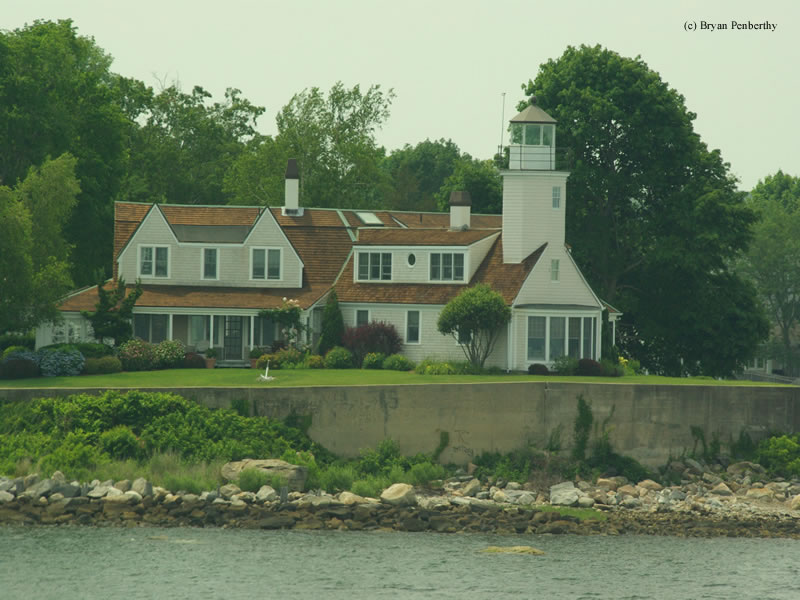Poplar Point Lighthouse
North Kingstown, Rhode Island - 1831 (1831**)

History of the Poplar Point Lighthouse
Posted/Updated by Bryan Penberthy on 2013-01-04.
Many speculate that the Poplar Point Lighthouse was never meant to guide vessels along the heavily transited West Passage of Narragansett Bay, but rather to mark the entrance to Wickford Harbor several miles off the main channel.
Congress appropriated $3,000 for the establishment of a lighthouse at Poplar Point. To provide a suitable location for the lighthouse, a three acre parcel of land on the southern shore was purchased from Thomas and Sarah Albro for $300 on April 16, 1831.
Contractor Charles Allen of Kingston, Rhode Island was employed to erect the lighthouse at a cost of $1,889. Per the specifications, he fabricated a one-story stone dwelling with an attached octagonal wooden tower at the eastern end. The tower rose eight feet above the roof line and was topped off by an eight-sided iron lantern.
Illumination of the tower was handled by Winslow Lewis. He supplied his patented lamp and reflector system for $375, which provided a fixed white light. The tower was put into service on the night of November 1, 1831 by Keeper Samuel Thomas, Jr. He was paid an annual salary of $350.
An inspection report of 1838 from Lieutenant George M. Bache revealed that the lighthouse was well kept and illuminating apparatus was in good condition. The report then went on to point out that the lighthouse did very little for the navigation of Narragansett Bay's West Passage, and that the number of vessels that called Wickford Harbor home was twenty with fifteen engaging in trade, and five in fishing.
Bache reported that he had no way of knowing how many nightly arrivals and departures took place at Wickford Harbor but estimated that the number would be low with most vessels favoring better anchorage between Conanicut and Dutch Islands.
The mid-1850s is when the Lighthouse Board embraced the Fresnel lens and started outfitting most lighthouses with the new technology. A fifth-order Fresnel lens was installed, and the eight lamps were replaced with a single Argand oil lamp.
By 1868, the tower was in poor condition with a number of issues. Access to the tower was through a dark and unventilated bedroom. The wooden tower was lined with bare studs, so consequently cold and snow permeated into the bedroom. The wall facing the water was in dilapidated condition caused principally by frost, the lantern was leaky, and there was no storage for supplies.
It was recommended that a new lantern replace the leaking one, a partition be put up to separate the tower from the bedroom, a dormer window be installed to provide proper ventilation, and that nothing be done about the dilapidated wall due to the high cost to replace it.
Finally, in 1870, Congress appropriated $12,300 for repairs and renovations at Poplar Point, Watch Hill, Gardiners Island, and the Horton Point lighthouses. The renovations listed above were addressed, but the lighthouse would only stay in service approximately twelve more years.
Prior to the 1870, Conanicut Island was mostly agricultural. However, in 1870, the Wickford Railroad and Steamboat Company began a steamship service between Wickford and Newport. This allowed New York's wealthy residents to board a train in New York operated by The New York, Providence, & Boston Railroad Company which provided service to Wickford. From there, the passengers could enjoy a 75-minute ferry service to Newport. Many New Yorker's favored this route to the lengthier Long Island steamer service. This was the start of area's increasing popularity as a vacation destination.
As increased traffic began using the port, it was recommended that a new lighthouse be constructed off-shore from Poplar Point at Old Gay Rock. On June 15, 1880, Congress appropriated $45,000 for the Wickford Harbor Lighthouse. It which went into service on November 1, 1882, at which point, the Poplar Point Lighthouse was discontinued.
By 1894, the Poplar Point Lighthouse was deemed excess, and sold at a public auction on October 15, 1894. The winning bidder was Albert R. Sherman of Pawtuxet, Rhode Island with a bid of $3,944.67. The lighthouse was mostly used as a summer residence from then on, but some of the more recent owners have lived in it year round.
The Wickford Harbor Lighthouse at Old Gay Rock was discontinued in 1930 and demolished soon after. It was replaced with an automated skeletal tower in 1939.
Note: The lighthouse is private property, please respect this and do not trespass.
Reference:
- Northeast Lights - Lighthouses and Lightships, Robert G. Bachand, 1989.
- America's Atlantic Coast Lighthouses (6th edition), Jeremy D'Entremont, 2005.
- Annual Report of the Light House Board, U.S. Lighthouse Service, Various years.
- New England Lighthouses: A Virtual Guide website.
Directions: The lighthouse is best viewed from the water. Rhode Island Bay Cruises offers a 10 lighthouse cruise that passes by the lighthouse.
Access: The lighthouse is private property. Grounds and tower closed.
View more Poplar Point Lighthouse picturesTower Height: 26.00'
Focal Plane: 48'
Active Aid to Navigation: Deactivated (1882)
*Latitude: 41.57100 N
*Longitude: -71.43900 W
See this lighthouse on Google Maps.
